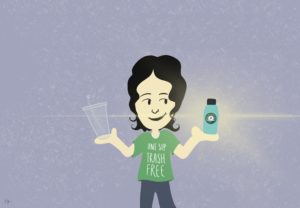
Illustrated by Julianne Park. All rights reserved.
What is hazardous waste?
Hazardous waste is simply a category of waste with toxic or dangerous properties that can harm human health or the environment. Examples include car batteries, paints, and solvents.
There are several types of hazardous waste.
The first type is organic compounds, which would include pesticides and solvents. The second type is toxic heavy metals, including lead and arsenic. The third is highly radioactive waste from nuclear power plants and facilities.
Hazardous waste can come from all around you. Even in your home!
Like the window and toilet cleaners in your bathroom cupboard. Or the paint and wood preservatives in the shed. Or the pesticides and weed killers you sprinkle over your lawn. Or the batteries in your electronics. Or the gasoline your car runs on. It’s everywhere. And that’s why it’s all the more important to dispose of it properly.
What can you do at home?
1. Never dump hazardous chemicals (e.g. paints, solvents, oil, antifreeze, pesticides) down the toilet, drain (storm drains too), ground, and into the garbage.
2. Do not throw old fluorescent lightbulbs that contain mercury. Check out our Take Action page to find your nearest lightbulb recycling facility.
3. Reduce your use of hazardous chemicals.
Use alternatives that are not hazardous.
Use vinegar instead to polish metals, clean, or remove stains.
Use baking soda to clean utensils and remove stains.
What can the government do?
1. Enforce a cradle-to-grave system so that permit holders must be responsible from the point the waste is generated (cradle) to the point the waste is disposed of properly (grave).
2. Strengthen the Toxic Substances Control Act.
* It does not require the funding needed to evaluate thousands of chemicals.
3. Renew tax on oil and chemical companies that expired in 1995 for the Superfund Act.
* Since 1995, after Congress faced immense pressure from polluting industries, the tax was not renewed. As a result, when a responsible party for a clean-up was not found, the taxpayers, not the polluters, paid for the cost. The clean-up process has slowed. This tax must be renewed.
4. Encouraging cradle-to-cradle systems.
5. Enforce full-cost pricing of all products. This means including the harmful environmental and health costs of a product’s lifespan.
6. Give tax breaks and subsidies to recycling or reusing facilities rather than fossil fuel extraction industries.
7. Decrease subsidies and tax breaks for industries that produce from virgin resources. Increase subsidies and tax breaks for industries that reuse and recycle.
Additional Information:
https://www.epa.gov/toxics-release-inventory-tri-program
Work Cited:
“Take Action – the Earth Chronicles.” Earth Chronicles, earthchronicles.org/answers-to-questions/. Accessed 7 Feb. 2023.
US EPA. “Summary of the Toxic Substances Control Act | US EPA.” US EPA, 19 Sept. 2018, www.epa.gov/laws-regulations/summary-toxic-substances-control-act.
US EPA, OP. “Summary of the Comprehensive Environmental Response, Compensation, and Liability Act (Superfund).” US EPA, 22 Feb. 2013, www.epa.gov/laws-regulations/summary-comprehensive-environmental-response-compensation-and-liability-act#:~:text=The%20Comprehensive%20Environmental%20Response%2C%20Compensation%2C%20and%20Liability%20Act%20%2D%2D%20otherwise.
US EPA,OEI. “Toxics Release Inventory (TRI) Program | US EPA.” US EPA, 31 Jan. 2013, www.epa.gov/toxics-release-inventory-tri-program.
The views and opinions expressed are those of the authors and do not necessarily reflect nor represent the Earth Chronicles and its editorial board.









